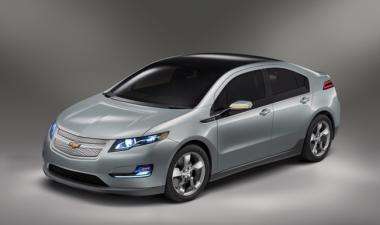Volt: GM's car of the future?

The Chevrolet Volt is many things: an attention grabber, a potential cure for an oil dependent nation - the list goes on.
It is not, however, designed for an apartment dweller.
Without a garage or driveway, I parked the hybrid electric vehicle in the street. This presented some concerns: Would my neighbors steal the charging plug? Would I need an extension cord to reach the socket in my apartment? Would rain blow up the car?
It was after 10 p.m. Thursday - the answers were not readily available, so I left the car uncharged among its gas-guzzling peers.
Fortunately, the Volt has a traditional gasoline-powered engine, which I used Friday morning to start the car and drive to work.
That, in a nutshell, is the promise of the Volt: It offers about 35 miles of pin-drop-quiet, gasoline-free driving. When the battery dies, the combustion engine kicks on - I hardly noticed it while driving on the Monitor-Merrimac Memorial Bridge Tunnel - in a seamless transition.
"The fact of the matter is: It's an awesome vehicle," said Scott Gregoire, a salesman at Casey Auto Group, which lent its Volt to the newspaper for a day. "It's going to change the way people drive."
Before discussing that, here's a primer on the Volt:
Introduced in select markets last year, the Volt is the most anticipated car from General Motors in years. It is expected to reverse the fortune of the cash-strapped automotive giant, out-compete foreign competitors and prove that plug-in cars are viable to a nation of wary motorists.
Charging issues aside, I had no difficulties with the Volt. The four-door hatchback has plenty of pep, is easy to handle and has enough gadgets to satisfy the most tech-savvy drivers.
For example, the Volt's touch screen center console shows the energy created from applying the brakes being directed to the electric battery, a 435-pound, T-shaped colossus that sits under the seats.
There's another feature that shows how fuel efficient the car is performing. The gauge fluctuates from 35 miles per gallon to hundreds depending on the power source. For the record, a full tank of gas - 9.3 gallons - and a fully charged battery deliver 379 miles, according to tests performed by the U.S. Environmental Protection Agency.
GM says the Volt will help wean the nation off imported oil, which contributes to high gas prices. What it doesn't say - at least not as loudly - is that electric cars will be a significant drain on the nation's power grid.
While a novelty now, one report estimates Virginia, for example, will have 86,000 electric vehicles by 2020. That includes the Volt, the Nissan Leaf and the all-electric Ford Focus, which has already been shown in Richmond.
The cars will require 270 megawatts of energy, about what a small power plant produces, said Tom Kazas, a spokesman for Dominion Resources, the state's largest utility company.
The U.S. Department of Energy states that electric vehicles on average emit less carbon dioxide, which most climate scientists link to global warming, than conventional or hybrid vehicles. Its figures are based on a blend of the nation's power sources.
The axiom may not apply to regions heavily dependent on fossil fuels. Virginia derives most of its fuel from coal-fired power plants, though it also relies on nuclear power and is moving toward natural gas, which burns cleaner than coal.
Starting in October, Dominion will offer a program that gives electric vehicle owners discounted rates for charging their cars overnight when power demand is at its least. Drivers will pay more when charging during peak hours.
Virginia Clean Cities, an environmental group that works to reduce oil consumption in the transportation sector, supports the program. Alleyn Harned, the group's director of business development, hopes electric vehicles will help spur renewable energy projects, such as wind and solar farms.
Meanwhile, the infrastructure needed to support electric vehicles is growing. The number of charging stations in Virginia grew from four in January to at least 28 currently, Harned said.
"Things are going gangbusters," he said.
Most stations are in northern Virginia, where Volts debuted nearly a year ago. Despite the hype surrounding the Volt, more people are buying Leafs.
Nissan sold 3,875 Leafs the first six months of this year, compared to 2,745 Volts during the same time frame. The Leaf does not have a combustion engine; its battery runs for 100 miles before needing recharging.
Both cars cost a little more than $30,000, though Volt owners must apply for a $7,500 federal tax rebate.
I eventually charged the Volt after finding a socket outside the newspaper office. I eventually found that using an extension cord is not recommended, which could be a problem for street-parking motorists.
Recharging the Volt's battery with a standard 120-volt socket takes about 10 hours - I had it plugged in for five hours at work, plenty of juice to get it back to the dealership in electric mode. Motorists can buy an adapter that cuts the charge time in half.
As for the rain, GM says it's not a problem provided the hookup is properly set. Whether or not my neighbors would tamper with the thing, well, that's another story.
(c)2011 the Daily Press (Newport News, Va.)
Distributed by MCT Information Services



















